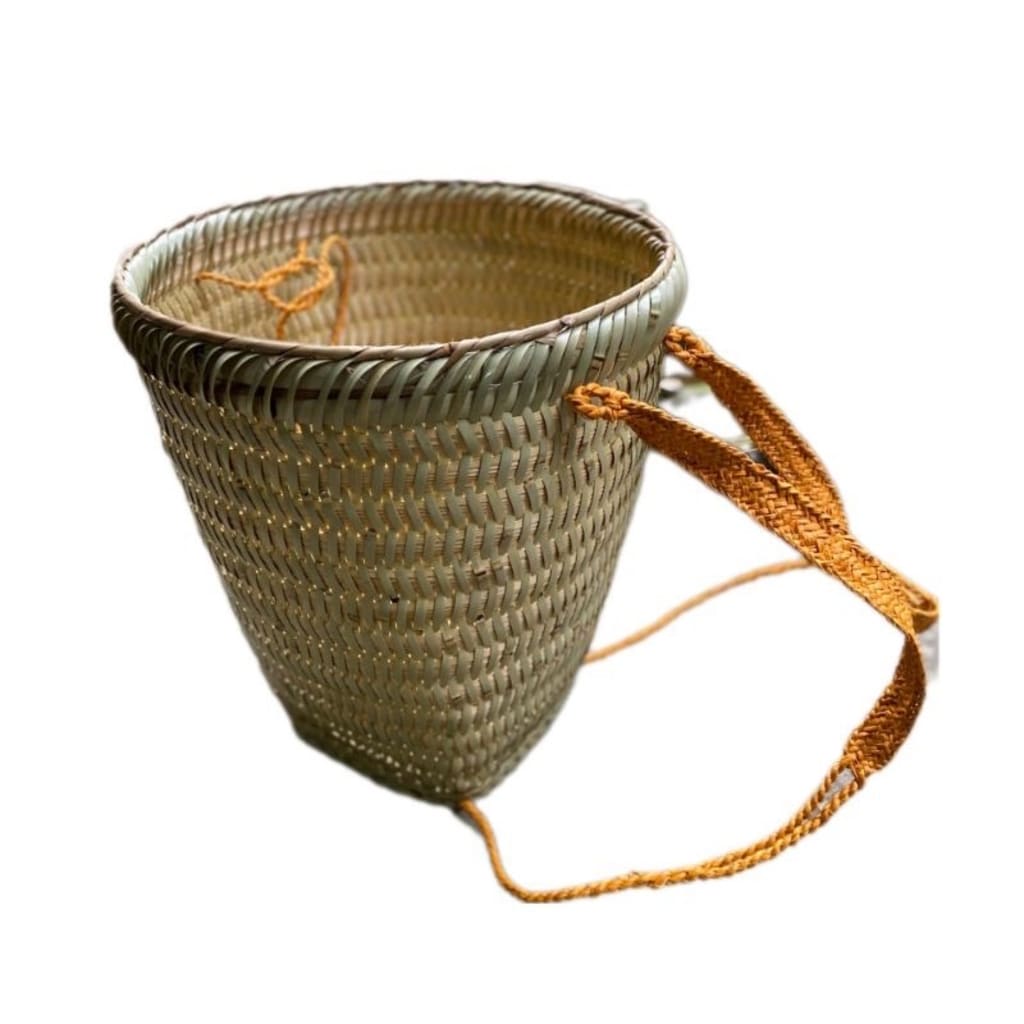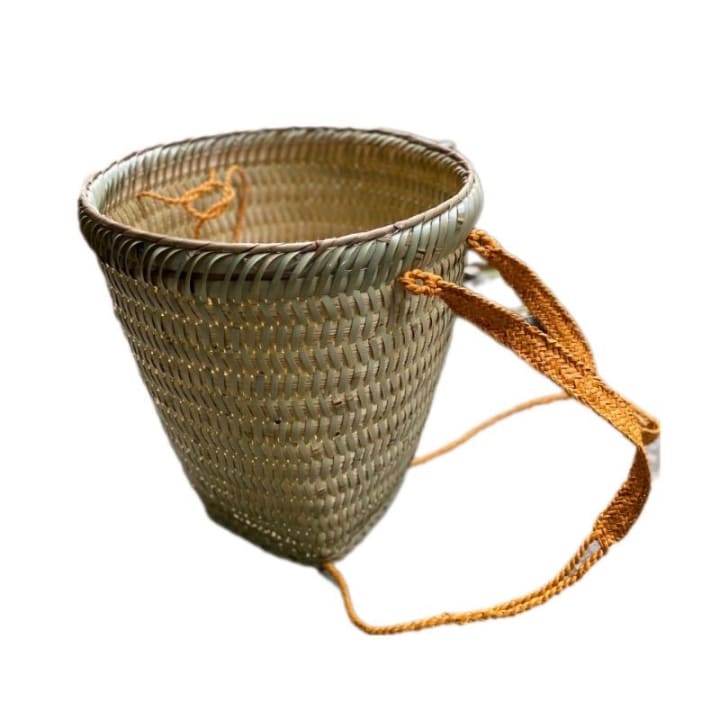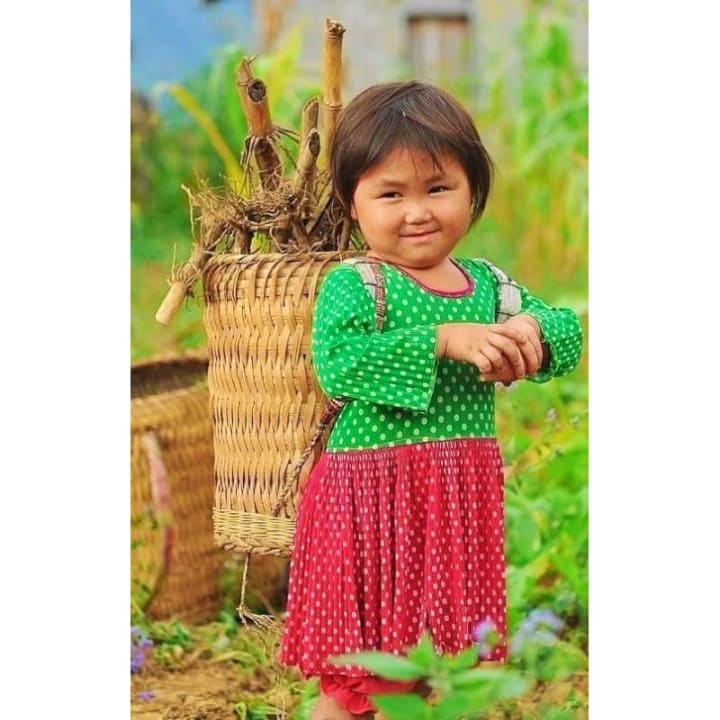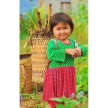Introducing bamboo baskets, also known as backpacks, of the Vietnamese Dao ethnic group
The Vietnamese Dao ethnic group

The Vietnamese Dao ethnic group, one of the 54 ethnic groups in Vietnam, is renowned for its unique cultural artifacts, including the bamboo baskets or backpacks they create and use. These baskets, known locally as "Gùi," are a significant part of Dao culture and daily life.

Characteristics of Dao Bamboo Baskets
1. Materials:
o Bamboo: The primary material, bamboo, is abundant in the mountainous regions where the Dao people reside. Bamboo is chosen for its strength, flexibility, and light weight.
o Rattan: Sometimes, rattan is used alongside bamboo for additional durability and aesthetic appeal.
2. Design:
o Structure: These baskets typically have a cylindrical shape with an open top, allowing for easy loading and unloading of goods.
o Straps: They are equipped with two shoulder straps, enabling them to be worn like backpacks. The straps are usually made from woven bamboo or fabric.
o Patterns: Decorative patterns, often geometric or inspired by nature, are woven into the baskets, showcasing the craftsmanship and artistic expression of the Dao people.
3. Functionality:
o Multi-purpose Use: Dao bamboo baskets are used for various purposes, including carrying agricultural products, firewood, and personal belongings. They are essential for daily activities and during traditional festivals.
o Ergonomic Design: The design of the straps and the lightweight nature of bamboo make these baskets comfortable to carry, even when loaded with heavy items.
4. Cultural Significance:
o Symbol of Identity: The bamboo basket is a symbol of the Dao ethnic group’s identity and heritage. It represents their connection to nature and their traditional way of life.
o Generational Craft: Basket weaving is a skill passed down through generations, with techniques and patterns being taught from elders to the younger members of the community.
Production Process

1. Harvesting Bamboo: Bamboo is harvested from local forests, ensuring sustainable practices are followed to maintain the ecological balance.
2. Processing Bamboo: The harvested bamboo is cut into strips and dried to prevent mold and decay. The strips are then treated to enhance durability.
3. Weaving: Skilled artisans weave the bamboo strips into intricate patterns, creating the body and straps of the basket. This process requires patience and precision.
4. Finishing Touches: Additional decorations and reinforcements are added, and the basket is checked for quality and functionality.
Preservation of Craft
Efforts are being made to preserve this traditional craft in the face of modernization. Cultural programs and initiatives aim to support the artisans and promote the significance of bamboo baskets within and outside Vietnam.
These bamboo baskets not only serve practical purposes but also stand as a testament to the rich cultural heritage and craftsmanship of the Dao ethnic group.
* Vietnamese Dao ethnic culture
The Dao ethnic group, also known as the Yao or Zao, is one of Vietnam's 54 officially recognized ethnic groups. The Dao people have a rich and diverse culture, characterized by distinct customs, traditional practices, and vibrant arts. Here are some key aspects of their culture:
1. Language
The Dao people speak various dialects of the Dao language, which belongs to the Hmong-Mien language family. Vietnamese is also commonly spoken, especially among younger generations and in more urbanized areas.
2. Traditional Clothing
• Men: Dao men typically wear long tunics with trousers. The tunics are often adorned with intricate embroidery and silver ornaments.
• Women: Dao women's clothing is more elaborate, featuring colorful embroidered patterns, long skirts, and headscarves. The embroidery often includes motifs of animals, plants, and geometric shapes, symbolizing different aspects of their culture and beliefs.
3. Housing
Dao homes are traditionally built on stilts, although some subgroups live in ground-level houses. The houses are constructed using locally available materials such as wood, bamboo, and palm leaves. The architecture reflects their adaptation to the mountainous terrain and the need for protection against wild animals and floods.
4. Customs and Traditions
• Weddings: Dao wedding ceremonies are elaborate and involve various rituals to ensure the couple's happiness and fertility. The groom's family typically provides a dowry to the bride's family.
• Funerals: Funeral rites are crucial in Dao culture, as they believe in the importance of guiding the deceased's soul to the afterlife. The rituals involve offerings, chants, and sometimes the practice of exhuming and reburying bones to ensure proper passage to the afterlife.
• New Year Celebration: Known as Tết Nhảy or Dance Festival, this celebration involves various traditional dances, music, and offerings to ancestors and deities.
5. Religious Beliefs
The Dao practice a mix of animism, ancestor worship, and Taoism. They believe in the presence of spirits in natural elements and perform rituals to appease these spirits. Ancestor worship is central to their spiritual life, with regular offerings and ceremonies conducted to honor their forebears.
6. Traditional Arts and Crafts
• Embroidery: The Dao are famous for their intricate embroidery, which is a skill passed down through generations. The designs often depict symbolic motifs and are used to decorate clothing and accessories.
• Silver Jewelry: Dao women wear elaborate silver jewelry, including necklaces, bracelets, and earrings, which are not only decorative but also believed to have protective properties.
• Woodwork and Bamboo Weaving: The Dao people are skilled in wood carving and bamboo weaving, creating everyday items like baskets, tools, and furniture.
7. Festivals
• Pan-Nu-Kin (Full Moon Festival): Celebrated on the 15th day of the eighth lunar month, this festival involves offerings to the Moon Goddess and ancestor worship.
• Cap Sac Ceremony: This is an important rite of passage for Dao men, marking their transition to adulthood. It involves various rituals, including animal sacrifices and the bestowal of a new name.
8. Agriculture
Agriculture is the main livelihood of the Dao people, with rice and maize being the primary crops. They practice both wet rice cultivation in terraced fields and swidden agriculture. In addition to farming, they also engage in animal husbandry, hunting, and gathering forest products.
9. Cuisine
Dao cuisine is characterized by the use of fresh, locally sourced ingredients. Common dishes include sticky rice, bamboo shoots, and various herbs. They also prepare traditional fermented foods and beverages, such as rice wine, which plays a significant role in their social and ceremonial life.
10. Community Life
The Dao communities are close-knit, with strong family ties and communal support systems. Village elders play an essential role in maintaining traditions, mediating disputes, and guiding communal decisions.
Preservation Efforts
As with many indigenous cultures, the Dao face challenges from modernization and cultural assimilation. Efforts are being made to preserve their cultural heritage through documentation, cultural tourism, and educational programs aimed at younger generations.
The Dao ethnic group continues to maintain its rich cultural heritage, adapting to modern influences while preserving its unique traditions and identity.
About the Creator
Enjoyed the story? Support the Creator.
Subscribe for free to receive all their stories in your feed. You could also pledge your support or give them a one-off tip, letting them know you appreciate their work.






Comments
There are no comments for this story
Be the first to respond and start the conversation.